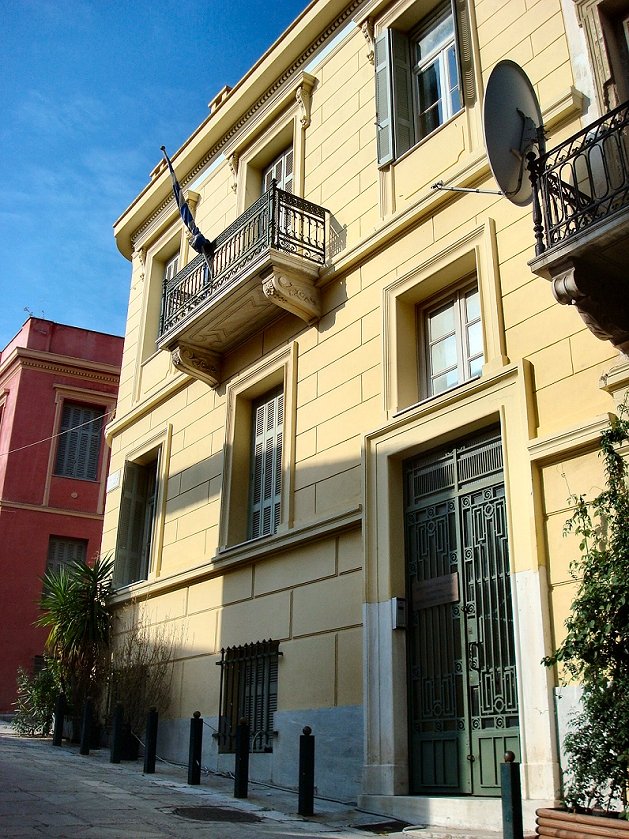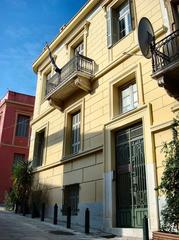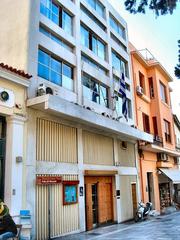
Museum of Greek Folk Art: Visiting Hours, Tickets & Complete Guide to Athens Historical Sites
Date: 14/06/2025
Introduction: A Gateway to Greece’s Living Traditions
Immerse yourself in the vibrant heritage of Greece at the Museum of Greek Folk Art, an essential destination nestled in the historic heart of Athens. Founded in 1918, the museum was established to preserve and celebrate the rich tapestry of Greek folk traditions beyond the city’s ancient classical monuments. Through its extensive collections, educational programs, and historic venues, the Museum of Greek Folk Art offers a unique perspective on the everyday lives, artistic expressions, and regional customs that have shaped modern Greece (Museum of Greek Folk Art Official Site, This is Athens).
Location and Access
Situated in the picturesque Plaka neighborhood, the museum’s several annexes are within easy walking distance of major landmarks such as the Acropolis, Monastiraki Flea Market, and the Roman Agora. This central location allows visitors to combine their museum experience with a broader exploration of Athens’ historical sites.
- [On Foot: 10 minutes from Syntagma Square, following well-marked paths through Plaka’s scenic streets (Greeka).](#on-foot:-10-minutes-from-syntagma-square,-following-well-marked-paths-through-plaka’s-scenic-streets-(greeka).)
- Metro: Akropoli (Red Line), Monastiraki, and Syntagma stations are the closest metro stops.
- Taxi: Pre-booked transfers and local taxis are widely available.
Museum Structure and Annexes
The museum operates across multiple historic buildings, each highlighting different aspects of Greek folk culture. Note that as of June 2025, some buildings are temporarily closed for renovations—always check the official museum website for the latest updates.
Main Buildings
- Central Building (17 Kydathinaion Street): Currently closed for renovation.
- Tzisdarakis Mosque (Monastiraki Square): Traditionally hosts the V. Kyriazopoulos Collection of Folk Pottery; temporarily closed.
- Bath House of the Winds (8 Kyrristou Street): Open to visitors, featuring exhibitions on traditional Ottoman-era public bath culture.
- Museum at 22 Panos Street: Open Tuesday–Sunday, showcasing traditional tools, crafts, and artifacts from daily Greek life.
Summary Table: Museum Annexes
| Location | Address | Main Focus | Notable Features |
|---|---|---|---|
| Bath House of the Winds | 8 Kyrristou St. | Bathing culture, Ottoman social history | Only surviving Ottoman bath in Athens |
| 22 Panos Street | 22 Panos St. | Traditional tools and crafts | Hands-on displays of daily life artifacts |
| Central Building | 17 Kydathinaion St. | (Closed for renovation) | Usually houses permanent folk art collections |
| Tzisdarakis Mosque | Monastiraki Square | (Closed for renovation) | Historically housed extensive pottery collection |
Museum Visiting Hours (June 2025)
- Bath House of the Winds: Open Monday, Wednesday to Sunday, 9:00 a.m. – 4:00 p.m.; closed Tuesdays.
- 22 Panos Street Annex: Open Tuesday to Sunday, 9:00 a.m. – 4:00 p.m.; closed Mondays.
- Other Sites: Central Building and Tzisdarakis Mosque remain closed for renovations.
Always verify current schedules on the official museum website before your visit.
Tickets and Admission
- Standard Admission: Varies by building and exhibition. Only the Bath House of the Winds and 22 Panos Street annexes are accessible as of June 2025.
- Free Admission: Under 19s, EU students, students of classical or art studies, military personnel, journalists, ICOM members, licensed guides, and visitors with disabilities.
- Free Admission Days: March 6, April 18, May 18 (International Museum Day), October 28 (Ohi Day), European Heritage Days, June 5, and September 27.
- Discounts and Updates: Check current rates and any special offers on the museum’s official page.
Collection Highlights
Embroidery, Textiles, and Regional Costumes
The museum’s renowned textile collection spans four centuries of Greek embroidery, costumes, and linens. Regional bridal dresses, gold-thread embroidery from Epirus, and unique motifs from the Dodecanese exemplify Greece’s diverse cultural identities.
Folk Pottery and Ceramics
The V. Kyriazopoulos Collection (traditionally in the Tzisdarakis Mosque) features utilitarian and ceremonial ceramics from across Greece, including Sifnos’ black-glazed wares and Skyros’ colorful pottery.
Shadow Theatre and Folk Entertainment
Discover the world of “Karagiozis” shadow puppetry—a blend of satire, humor, and social commentary—and artifacts related to Greek festivals, musical instruments, and masquerade costumes.
Ecclesiastical and Domestic Objects
Highlights include bread stamps, ecclesiastical embroidery, everyday utensils, votive offerings, and silverwork, reflecting both domestic life and religious practices.
Ottoman Bath Culture
The Bath House of the Winds offers a rare glimpse into the social and architectural history of Ottoman public baths, focusing on their role as community hubs and their unique architectural features.
Educational Programs and Events
The museum is committed to cultural preservation and public engagement, offering:
- Workshops: Hands-on sessions in embroidery, pottery, and weaving.
- Guided Tours: Available in Greek and English with advance booking.
- Temporary Exhibitions: Rotating displays on topics like wedding traditions, folk music, and contemporary interpretations of folk art.
- Library and Research: Over 5,000 volumes on folk art and ethnology are available for researchers and interested visitors (Museum of Greek Folk Art Education).
Accessibility and Visitor Experience
- Physical Access: The Bath House of the Winds and 22 Panos Street annex offer partial accessibility; some historic sites may have limitations. Contact the museum for specific access needs.
- Language: Most exhibits have Greek and English labels. English-language guided tours may require advance arrangements.
- Photography: Allowed in most areas without flash; check for specific restrictions.
Practical Tips for an Enriching Visit
- Duration: Allow 1–2 hours per annex.
- Best Times: Visit on weekday mornings for a quieter experience; avoid peak hours and free admission days if you seek tranquility.
- Facilities: Gift shop (Adrianou 43–45), restrooms in main annexes, and numerous nearby cafes in Plaka.
- Etiquette: Handle exhibits respectfully and supervise children. Avoid touching objects unless permitted.
Combining Your Visit with Athens Historical Sites
The museum’s prime location makes it ideal to combine with other key attractions such as the Acropolis, Ancient Agora, and Monastiraki Flea Market (Lonely Planet).
Frequently Asked Questions (FAQ)
Q: What are the current visiting hours for the Museum of Greek Folk Art?
A: Bath House of the Winds: Monday, Wednesday–Sunday, 9:00 a.m.–4:00 p.m., closed Tuesdays. 22 Panos Street: Tuesday–Sunday, 9:00 a.m.–4:00 p.m., closed Mondays.
Q: How much are tickets?
A: Prices vary by site. Many categories (under 19, students, etc.) are granted free entry. Check the official website for current rates.
Q: Is the museum wheelchair accessible?
A: Some historic buildings have limited accessibility. Contact the museum for detailed information.
Q: Are guided tours available in English?
A: English-language tours are available by arrangement; inquire in advance.
Q: Are there free admission days?
A: Yes, including International Museum Day (May 18), Ohi Day (October 28), and European Heritage Days.
Enhance Your Experience
- Audiala App: Download for audio guides and event updates.
- Social Media: Follow the museum for exhibition news and educational content.
- Plan Ahead: Verify opening hours and site accessibility before your visit.
Conclusion: A Cultural Jewel in Athens’ Historic Core
A visit to the Museum of Greek Folk Art offers an unparalleled journey through Greece’s folk heritage, bringing to life the artistry, customs, and daily experiences that continue to shape the national identity. By exploring its historic annexes, participating in educational activities, and combining your visit with nearby landmarks, you’ll gain a deeper appreciation for the living traditions of Greece. Stay informed through the museum’s platforms and enhance your visit with modern tools like the Audiala app.
Sources and Further Reading
- Museum of Greek Folk Art in Athens: Visiting Hours, Tickets, and Cultural Highlights, 2023, Hellenic Ministry of Culture (https://www.culture.gov.gr/DocLib/2017/Mouseio_Ellinikis_Laikis_Texnis.pdf)
- This is Athens: Museum of Greek Folk Art, 2023 (https://www.thisisathens.org/arts-culture/museums/museum-greek-folk-art)
- Museum of Greek Folk Art Official Site, 2023 (https://www.melt.gr/)
- Greek Folk Art Museum Collections, 2023 (https://www.melt.gr/collections/)
- Athens Info Guide: Museum of Greek Folk Art, 2023 (https://www.athensinfoguide.com/seeingsights/museums/museumofgreekfolkart.htm)
- Greek Travel Pages: Athens Museums 2023, 2023 (https://news.gtp.gr/2023/01/10/athens-museums-2023/)






















































































